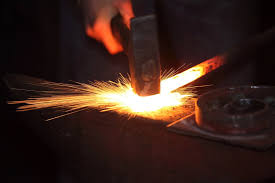For centuries, steel has been the backbone of civilization. From towering skyscrapers to delicate surgical instruments, its versatility and strength have made it an indispensable material. But not all steel is created equal. At the pinnacle of strength lies a special breed – forged steel. This article delves into the ancient art of steel forging, unveiling the secrets behind its remarkable properties and the applications that rely on its unmatched toughness.
The Birth of Strength: The Forging Process
Unlike its cast or rolled counterparts, forged steel undergoes a dramatic transformation. It begins as a red-hot bloom, a block of molten steel. This fiery heart is then subjected to immense pressure, typically through powerful hydraulic presses or hammering. This intense squeezing and pounding achieves two critical feats.
Firstly, it densifies the metal. Imagine a bowl of sand – full of air pockets and loosely packed. Forging compresses the steel, eliminating these voids and imperfections. This tighter packing translates to a stronger, more uniform structure.

Secondly, forging refines the grain structure of the steel. The high heat and pressure cause the microscopic crystals within the metal to elongate and align in the direction of force. This creates a "grain flow" that enhances the steel's resistance to stress and improves its ductility, the ability to deform without breaking.
The Alchemy of Strength: Alloying and Heat Treatment
Forging alone is a powerful tool, but it's not the sole contributor to super strong steel. Alloying introduces specific elements like chromium, nickel, or vanadium into the steel's composition. These elements act as microscopic reinforcements, further strengthening the grain boundaries and enhancing specific properties like corrosion resistance or high-temperature performance.
The final touch comes through meticulous heat treatment. Steel is heated to specific temperatures and then rapidly cooled (quenched) or cooled slowly. This process manipulates the internal structure, creating a balance between strength and ductility. For instance, quenching locks the steel in a harder, more brittle state, while slower cooling allows for a more balanced structure.
The Applications: Where Forged Steel Reigns Supreme
The unique properties of forged steel make it the go-to material for a variety of demanding applications:
- Crankshafts and Gears: In the heart of engines, forged steel components withstand immense forces and cyclical stresses. Their strength and fatigue resistance ensure smooth operation and prevent catastrophic failures.
- Aerospace Components: Aircraft landing gear, airframes, and critical engine parts rely on forged steel for their exceptional strength-to-weight ratio. The ability to handle high stresses without adding excessive weight is crucial for efficient and safe flight.
- Oil and Gas Drilling: Deep-sea exploration and drilling equipment encounter extreme pressure and harsh environments. Forged steel components like drill bits and pressure vessels can withstand these demanding conditions.
- Construction: Cranes, bridges, and other heavy-duty structures utilize forged steel for its exceptional load-bearing capacity and resistance to deformation.
A Legacy of Strength: The Future of Forging
Forging remains an essential process, even in the age of advanced materials. While newer alloys and composites are constantly emerging, forged steel offers a unique combination of proven performance, affordability, and versatility. As engineers continue to push the boundaries of design, forging will undoubtedly play a vital role in developing the next generation of super strong steels.
The Enduring Allure of Forged Steel
Beyond its practical applications, forged steel holds a certain mystique. The age-old process, the raw power involved, and the resulting exceptional strength all contribute to a sense of awe. It's a testament to human ingenuity, our ability to transform a raw material into something so remarkably robust. In a world increasingly dominated by digital simulations and automated processes, forging represents a connection to a more tangible, hands-on approach to shaping the world around us.
So, the next time you marvel at a towering skyscraper or witness the awe-inspiring power of a jet engine, remember the hidden strength within. It's a testament to the enduring power of steel forging, a process that continues to shape the world, one powerful blow at a time.

No comments yet